WEAK TYPE INEQUALITY FOR THE MAXIMAL OPERATOR OF WALSH-KACZMARZ-MARCINKIEWICZ MEANS∗
2016-09-26UshangiGOGINAVA
Ushangi GOGINAVA
Department of Mechanics and Mathematics,Tbilisi State University,Chavchavadze str.1,Tbilisi 0128,Georgia
E-mail∶zazagoginava@gmail.com
K´aroly NAGY
Institute of Mathematics and Computer Sciences,College of Ny´iregyh´aza,S´ost´oi str.31/B,4400 Ny´iregyh´aza,Hungary
E-mail∶nkaroly@nyf.hu
WEAK TYPE INEQUALITY FOR THE MAXIMAL OPERATOR OF WALSH-KACZMARZ-MARCINKIEWICZ MEANS∗
Ushangi GOGINAVA
Department of Mechanics and Mathematics,Tbilisi State University,Chavchavadze str.1,Tbilisi 0128,Georgia
E-mail∶zazagoginava@gmail.com
K´aroly NAGY
Institute of Mathematics and Computer Sciences,College of Ny´iregyh´aza,S´ost´oi str.31/B,4400 Ny´iregyh´aza,Hungary
E-mail∶nkaroly@nyf.hu
The main aim of this article is to prove that the maximal operator σκ∗of the Marcinkiewicz-Fej´er means of the two-dimensional Fourier series with respect to Walsh-Kaczmarz system is bounded from the Hardy space H2/3to the space weak-L2/3.
Walsh-Kaczmarz system,Marcinkiewicz-Fej´er means,Maximal operator,a.e. convergence,weak type inequality
2010 MR Subject Classification42C10
1 Introduction
For the two-dimensional Walsh-Fourier series,Weisz[1]proved that the maximal operator

is bounded from the two-dimensional dyadic martingale Hardy space Hpto the space Lpfor p>2/3.The d-dimensional version of this result was reached in[2].In[3]the author proved that in theorem of Weisz the assumption p>2/3 is essential;in particular it was showed that the maximal operator σw∗is not bounded from the Hardy space H2/3to the space L2/3. On the other hand,it is proved that in the endpoint case p=2/3,the maximal operator of the Marcinkiewicz-Fej´er means of the double Walsh-Fourier series is bounded from the dyadic Hardy space H2/3to the space weak-L2/3[4].

In 2006,the almost everywhere convergence of the Marcinkiewicz-Fej´er means of twodimensional Walsh-Kaczmarz-Fourier series was showed[15].Moreover,the second author discussed the properties of the maximal operator,that is,the maximal operator is of weak type(1,1)and of type(p,p)for all 1<p≤∞.In[16,17],it was proven that the maximal operatoris bounded from the dyadic Hardy-Lorentz space Hpinto Lpspace for every p>2/3. We also proved that the assumption p>2/3 is essential[18];in particular,we showed that the maximal operatoris not bounded from the Hardy space H2/3to the space L2/3.
In this article,we generalize the results of[15-17]for maximal operatorand prove that the maximal operatorof the Marcinkiewicz-Fej´er means with respect to the Walsh-Kaczmarz system is bounded from the Hardy space H2/3to the space weak-L2/3.
2 Definitions and Notations
Let P denote the set of positive integers,N:=P∪{0}.Denote Z2the discrete cyclic group of order 2,that is Z2={0,1},where the group operation is the modulo 2 addition and every subset is open.The Haar measure on Z2is given such that the measure of a singleton is 1/2.Let K be the complete direct product of the countable infinite copies of the compact groups Z2.The elements of K are of the form x=(x0,x1,···,xk,···)with coordinates xk∈{0,1}(k∈N). The group operation on K is the coordinate-wise addition,and the measure(denoted byµ)and the topology are the product measure and topology.The compact Abelian group K is called the Walsh group.A base for the neighbourhoods of K can be given in the following way[5,19]:

These sets are called dyadic intervals.Let 0=(0:i∈N)∈K denote the null element of K,In:=In(0)(n∈N).Set en:=(0,···,0,1,0,···)∈K,the nth coordinate of which is 1and the rest are zeros(n∈N).

For k∈N and x∈K,denote the kth Rademacher function.can be written,where ni∈{0,1}(i∈N),that is,n is expressed in the number system of base 2.Denote|n|:=max{j∈N:nj6=0},that is 2|n|≤n<2|n|+1.
The Walsh-Paley system is defined as the sequence of Walsh-Paley functions:

The Walsh-Kaczmarz functions are defined by κ0:=1 and for n≥1,

For A∈N,define the transformation τA:K→K by

By the definition of τA(see[9]),we have

The norm(or quasinorm)of the space Lpis defined by


The σ-algebra generated by the dyadic 2-dimensional cubes Ik×Ikof measure 2−2kwill be denoted by Fk(k∈N).
Denote by f=?f(n),n∈N?a one-parameter martingale with respect to(Fn,n∈N)(for details,see,for example,[1]).The maximal function of a martingale f is defined by
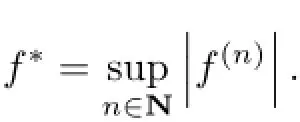
The space weak-Lpconsists of all measurable functions f for which
In case f∈L1,the maximal function can also be given by

where?x1,x2?∈K2.
For 0<p<∞,the Hardy martingale space Hpconsists of all martingales for which

A bounded measurable function a is a p-atom if there exists a dyadic 2-dimensional cube I2,suchR that
a)I2adµ=0;
b)‖a‖∝≤µ(I2)−1/p;
c)supp a⊂I2.
An operator T which maps the set of martingale into the collection of measurable functions are called p-quasi-local,if there exists a constant Cp>0 such that for every p-atom a,

holds,where I2is the support of the atom a.
The Dirichlet kernels are defined by
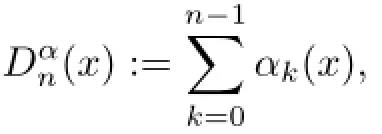
where αk=wk(for all k∈P)or κk(for all k∈P).Recall that

The Fej´er kernels are defined as follows:

The Kronecker product(αn,m:n,m∈N)of two Walsh(-Kaczmarz)system is said to be the two-dimensional Walsh(-Kaczmarz)system.Thus,

If f∈L1,then the numberˆfα(n,m):=K2fαn,m(n,m∈N)is said to be the(n,m)th Walsh-(Kaczmarz-)Fourier coefficient of f.We can extend this definition to martingales in the usual way(see Weisz[1,20]).Denote by Sαn,mthe(n,m)th partial sum of the Walsh-(Kaczmarz-)Fourier series of a martingale f.Namely,

The Marcinkiewicz-Fej´er means of a martingale f are defined by

In 1939,Marcinkiewicz[21]has proved for f∈LlogL([0,2π]2)that the means σnf defined for the two-dimensional trigonometric Fourier series converge a.e.to f as n→∞.Zhizhiashvili[22]improved this result for f∈L([0,2π]2).The analogous result for Walsh system belongs to Weisz[23];for Vilenkin system belongs to G´at[24].
The 2-dimensional Dirichlet kernels and Marcinkiewicz-Fej´er kernels are defined by

For the martingale f,we consider the maximal operators

and

3 Formulation of Main Results
Theorem 3.1The maximal operatoris bounded from the Hardy space H2/3to the space weak-L2/3.
Corollary 3.2(G´at,Goginava and Nagy[17])Let p>2/3.Then the maximal operatoris bounded from the Hardy space Hpto the space Lp.
4 Auxiliary Propositions
We shall need the following lemmas(see[1,17]).
Lemma 4.1(Weisz[1])Suppose that an operator V is sublinear and,for some 0<p<1,

for every p−atom a,where I×I denotes the support of the atom.If V is bounded from Lp1to Lp1for a fixed 1<p1≤∞,then

Lemma 4.2(G´at,Goginava and Nagy[17])Let m1≤m2,A>N,n<2A+1,and

Then,
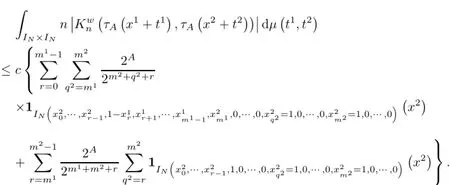
Lemma 4.3(G´at,Goginava and Nagy[17])Let A>N,n<2A+1,and

Then,

Lemma 4.4(G´at,Goginava and Nagy[17])Let A>N,n<2A+1,and

Then,

Lemma 4.5(Nagy[25])For k∈P and(x1,x2)∈K2,we have

Lemma 4.6(G´at,Goginava and Nagy[16])Let p>1/2.Then the maximal operatoris p-quasi-local(see inequality(2.1)).
5 Proofs of Main Results
Proof of Theorem 3.1We apply Lemma 4.1,and suppose that a∈L∝is a 2/3-atom with support IN×IN.As σna?x1,x2?=0,if n≤2Nwe may assume that n>2N(|n|≥N).
It is evident that

Step 1.Calculating over(KIN)×(KIN).Let n=2A+m,where 0≤m<2A(that is,|n|=A).Then from Lemma 4.5 and by equality(2.2),we have


Let m1,m2=0,···,N−1 such that

Then,applying Lemma 4.2,we get

Set

and

It is evident that B1x1,x26=0 implies that

and

for some r and q2,where 0≤r<m1,m1≤q2≤m2.
Consequently,

Let

As

we obtain

Hence,we can suppose that

It is simple to calculate

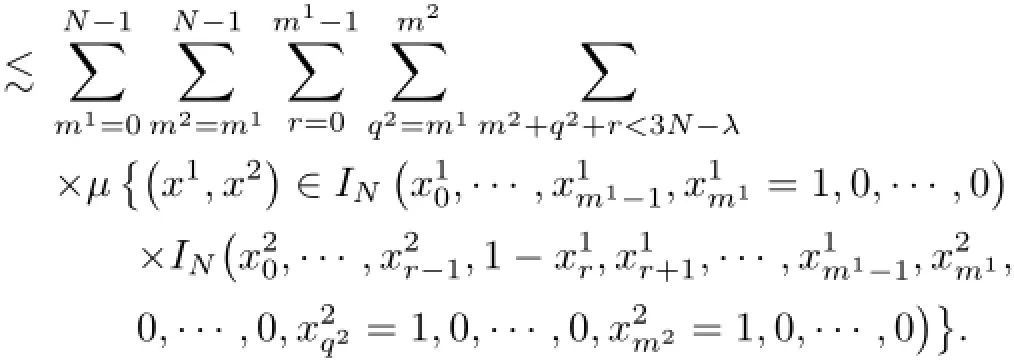
Set

Let

As

we conclude thatm2,q2/∈Ar.Hence,we can suppose that

Then,it is evident that

Consequently, Now,we discuss the term B2.It is evident that B2x1,x26=0 implies that
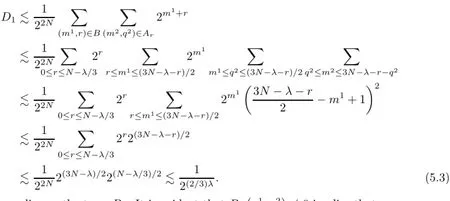

and

for some m1≤r≤m2,r≤q2≤m2.
Consequently,

Let

As

we conclude that

Hence,we can suppose that

Set

Then,we can write
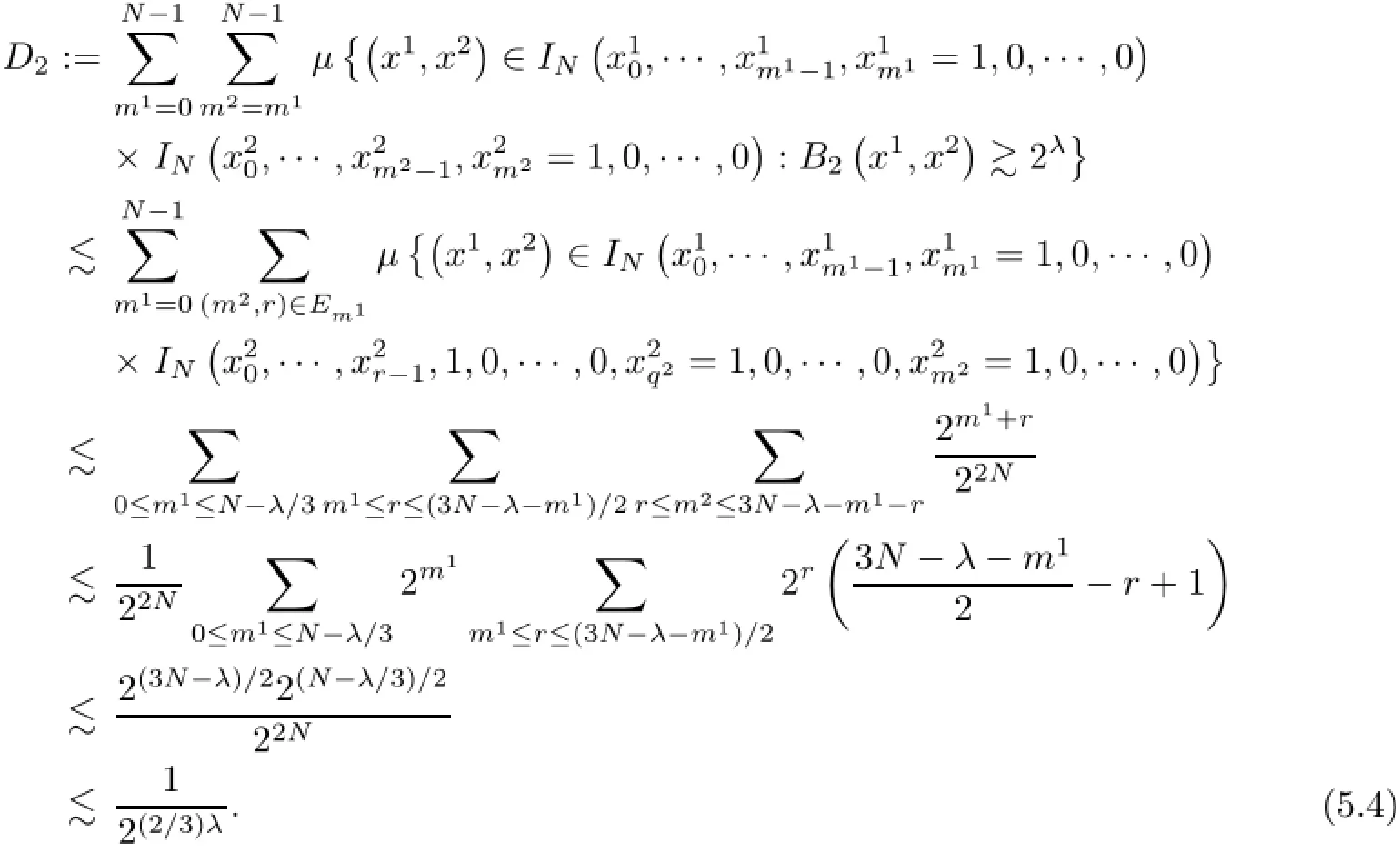
Combining(5.2)-(5.4),we conclude that

Step 2.Calculating over IN×(KIN).By Lemma 4.5 and equality(2.2),we have

As([17])


Then,

implies that

Then,we have
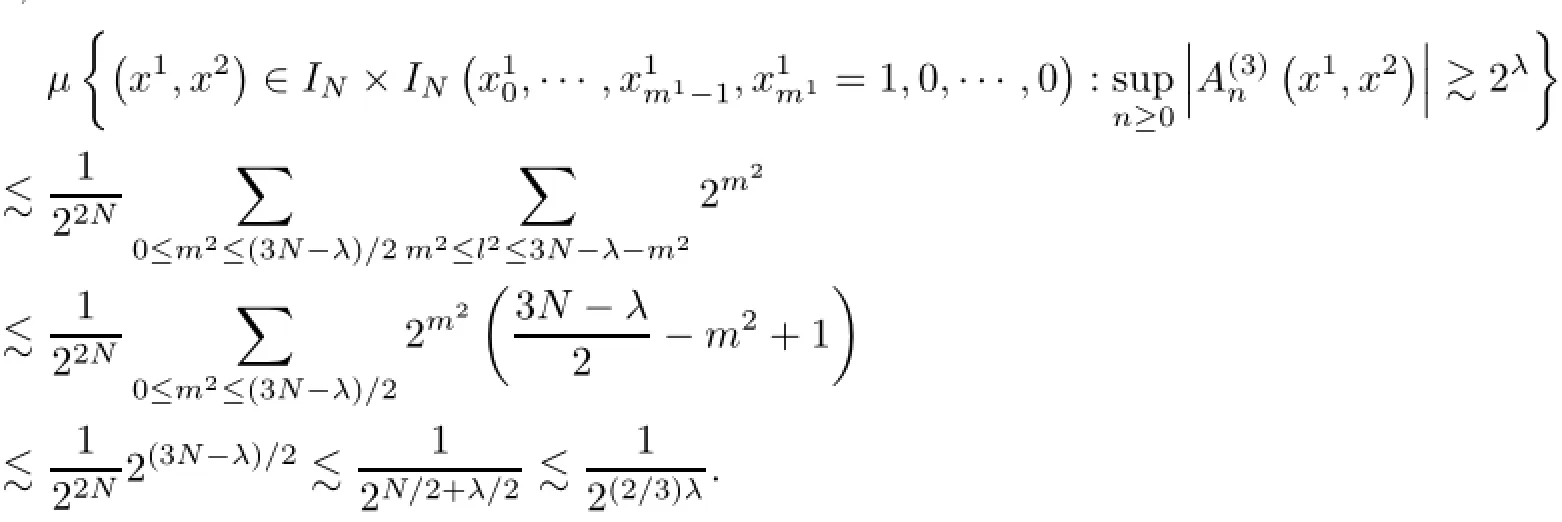
Applying Lemma 4.3,we get

Set

some 0≤r≤m2,r≤q2≤m2.Then we can write

Now,

implies that

We consider the following two cases.
a)Let 0≤q2≤(3N−λ)/2.Set

and

We can write that

Hence,we obtain
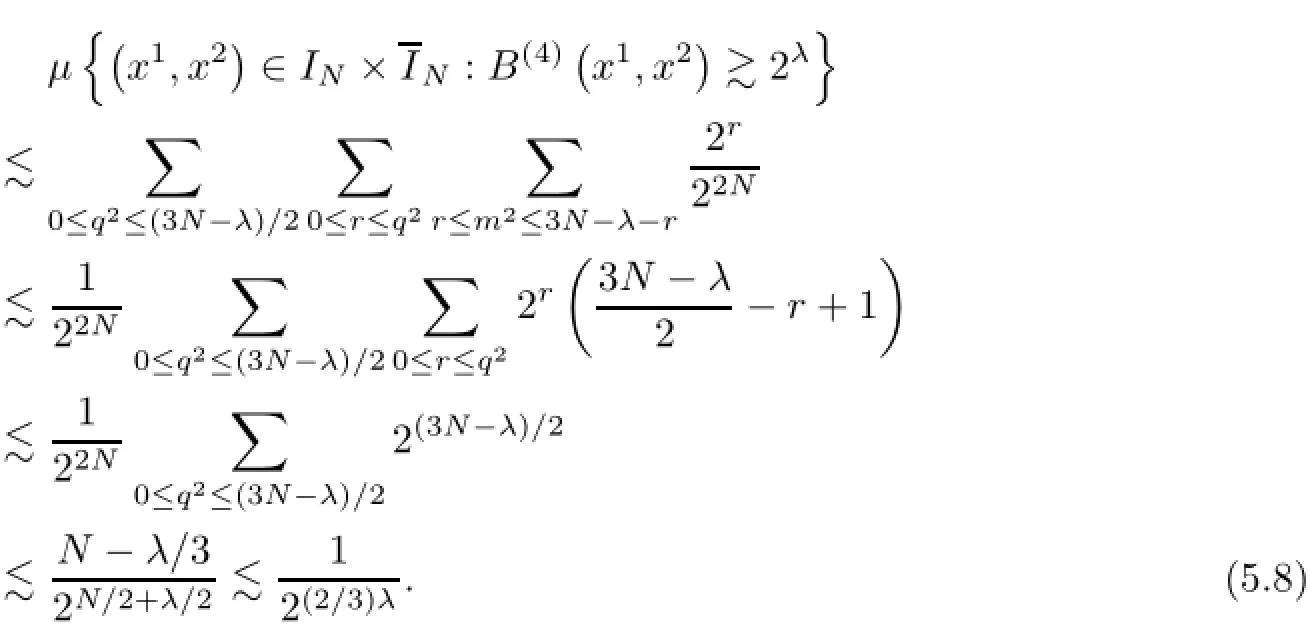
b)Let(3N−λ)/2<q2≤m2.This implies that

Consequently,
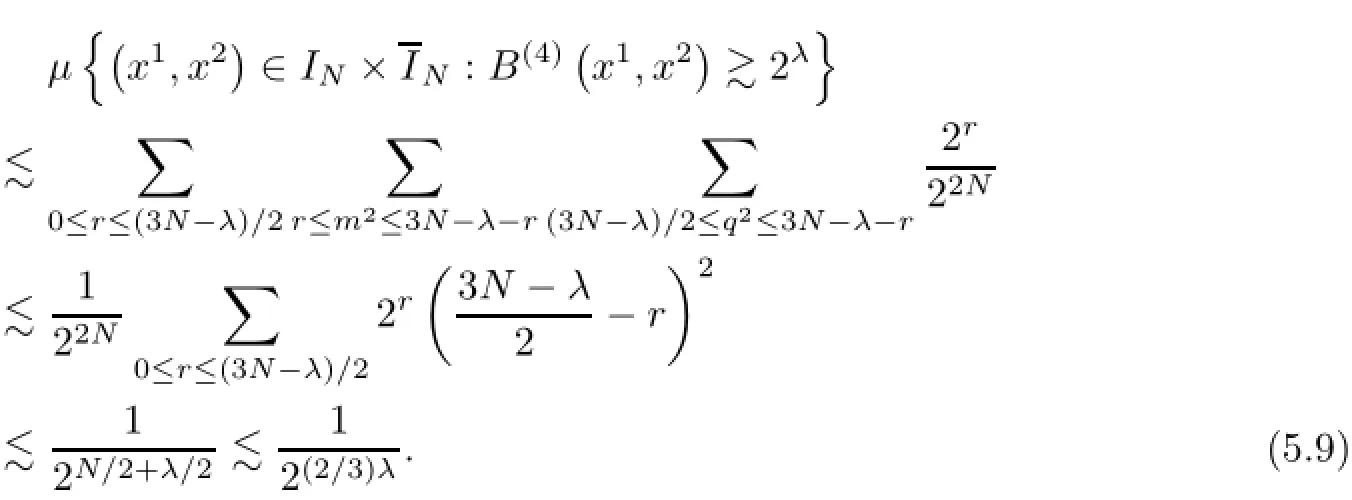
Combining(5.7)-(5.9),we conclude that

Step 3.Calculating over(KIN)×IN.This case is analogous to Step 2 and we immediately get

Combining(5.1),(5.5),(5.10),(5.11)and Lemma 4.6,we complete the proof of Theorem 3.1.
References
[1]Weisz F.Summability of multi-dimensional Fourier series and Hardy space.Dordrecht:Kluwer Academic,2002
[2]Goginava U.Marcinkiewicz-Fej´er means of d-dimensional Walsh-Fourier series.Math Anal and Appl,2005,307(1):206-218
[3]Goginava U.The maximal operator of Marcinkiewicz-Fej´er means of the d-dimensional Walsh-Fourier series. East J Approx,2006,12(3):295-302
[4]Goginava U.Weak type inequality for the maximal operator of the Marcinkiewicz-Fej´er means of the two-dimensional Walsh-Fourier series.J Approx Theory,2008,154:161-180
[5]Schipp F,Wade W R,Simon P,P´al J.Walsh Series,An Introduction to Dyadic Harmonic Analysis.New York:Adam Hilger Bristol,1990
[6]˘Sneider A A.On series with respect to the Walsh functions with monotone coefficients.Izv Akad Nauk SSSR Ser Math,1948,12:179-192
[7]Schipp F.Pointwise convergence of expansions with respect to certain product systems.Anal Math,1976,2:63-75
[8]Young W S.On the a.e.convergence of Walsh-Kaczmarz-Fourier series.Proc Amer Math Soc,1974,44:353-358
[9]Skvortsov V A.On Fourier series with respect to the Walsh-Kaczmarz system.Anal Math,1981,7:141-150[10]G´at G.On(C,1)summability of integrable functions with respect to the Walsh-Kaczmarz system.Studia Math,1998,130:135-148
[11]Simon P.On the Ces`aro summability with respect to the Walsh-Kaczmarz system.J Approx Theory,2000,106:249-261
[12]Goginava U.The maximal operator of the Fej´er means of the character system of the p-series field in the Kaczmarz rearrangement.Publ Math(Debrecen),2007,71(1/2):43-65
[13]Tephnadze G.On the maximal operators of Walsh-Kaczmarz-Fej´er means.Period Math Hungar,2013,67(1):33-45
[14]Tephnadze G.Approximation by Walsh-Kaczmarz-Fej´er means on the Hardy space.Acta Math Sci Ser B Engl Ed,2014,34(5):1593-1602
[15]Nagy K.On the two-dimensional Marcinkiewicz means with respect to Walsh-Kaczmarz system.J Approx Theory,2006,142:138-165
[16]G´at G,Goginava U,Nagy K.On(Hpq,Lpq)-type inequality of maximal operator of Marcinkiewicz-Fej´er means of double Fourier series with respect to the Kaczmarz system.Math Ineq Appl,2006,9(3):473-483[17]G´at G,Goginava U,Nagy K.On the Marcinkiewicz-Fej´er means of double Fourier series with respect to the Walsh-Kaczmarz system.Studia Sci Math Hung,2009,6(3):399-421
[18]Goginava U,Nagy K.On the maximal operator of the Marcinkiewicz-Fej´er means of double Walsh-Kaczmarz-Fourier series.Publ Math(Debrecen),2009,75(1/2):95-104
[19]Golubov B I,Efimov A V,Skvortsov V A.Series and transformations of Walsh.Moscow,1987(Russian);English translation.Dordrecht:Kluwer Academic,1991
[20]Weisz F.Martingale Hardy spaces and their applications in Fourier analysis.Berlin:Springer-Verlang,1994[21]Marcinkiewicz J.Sur une methode remarquable de sommation des series doubles de Fourier.Ann Scuola Norm Sup Pisa,1939,8:149-160
[22]Zhizhiashvili L V.Generalization of a theorem of Marcinkiewicz.Izv Akad Nauk USSR Ser Math,1968,32:1112-1122
[23]Weisz F.Convergence of double Walsh-Fourier series and Hardy spaces,Approx Theory and its Appl,2001,17:32-44
[24]G´at G.Convergence of Marcinkiewicz means of integrable functions with respect to two-dimensional Vilenkin systems.Georgian Math J,2004,11(3):467-478
[25]Nagy K.Some convergence properties of the Walsh-Kaczmarz system with respect to the Marcinkiewicz means.Rendiconti del Circolo Matematico di Palermo,Serie II,2005,76:503-516
October 28,2013;revised June 20,2014.The research was supported by project T´AMOP-4.2.2.A-11/1/KONV-2012-0051 and Shota Rustaveli National Science Foundation grant no.13/06(Geometry of function spaces,interpolation and embedding theorems).
杂志排行
Acta Mathematica Scientia(English Series)的其它文章
- MEAN-FIELD LIMIT OF BOSE-EINSTEIN CONDENSATES WITH ATTRACTIVE INTERACTIONS IN R2∗
- DIFFERENTIAL OPERATORS OF INFINITE ORDER IN THE SPACE OF RAPIDLY DECREASING SEQUENCES∗
- A BINARY INFINITESIMAL FORM OF TEICHMUüLLER METRIC AND ANGLES IN AN ASYMPTOTIC TEICHMUüLLER SPACE∗
- FAST ALGORITHM FOR CALDER´ON-ZYGMUND OPERATORS:CONVERGENCE SPEED AND ROUGH KERNEL∗
- ON THE CAUCHY PROBLEM OF A COHERENTLY COUPLED SCHRüODINGER SYSTEM∗
- A STABILIZED MIXED FINITE ELEMENT FORMULATION FOR THE NON-STATIONARY INCOMPRESSIBLE BOUSSINESQ EQUATIONS∗
